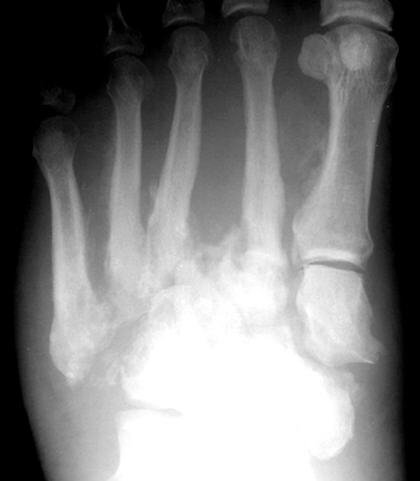
What is it?
Charcot arthropathy, also known as Charcot foot and ankle, is a syndrome in patients who have neuropathy or loss of sensation. It includes fractures and dislocations of bones and joints that occur with minimal or no known trauma.Symptoms and Clinical Presentation
Initially, there may be swelling, redness and increased warmth of the foot and ankle. Later, when fractures and dislocations occur, there may be severe deformities of the foot and ankle, including collapse of the midfoot arch (often called rocker bottom foot) or instability of the ankle and hindfoot. The syndrome progresses through three general stages:•Stage 1 (acute, development-fragmentation): marked redness, swelling, warmth; early radiographs show soft tissue swelling, and bony fragmentation and joint dislocation may be noted several weeks after onset
•Stage 2 (subacute, coalescence): decreased redness, swelling and warmth; radiographs show early bony healing
•Stage 3 (chronic, reconstruction-consolidation): redness, swelling, warmth resolved; bony healing or nonunion and residual deformity are frequently present.
Cause (including risk factors)
Charcot foot occurs in patients with peripheral neuropathy resulting from diverse conditions including diabetes mellitus, leprosy, syphilis, poliomyelitis, chronic alcoholism or syringomyelia. Repetitive microtrauma that exceeds the rate of healing may cause fractures and dislocations. Changes in circulation may cause resorption of bone, weakening the bone and increasing susceptibility to fracture and dislocation.Anatomy
Charcot arthropathy may affect any part of the foot and ankle, including (in decreasing order of frequency) the midfoot, hindfoot, ankle, heel and forefoot. Multiple regions may be involved concurrently. Fractures and dislocations frequently involve several bones and joints, with extensive fragmentation and deformity.Diagnosis
Time between onset of symptoms and diagnosis may be several weeks or months. Delay in diagnosis may or may not affect the end result because gross instability may occur even if prompt diagnosis is made. Diagnosis is based on a high index of suspicion for this problem in patients with neuropathy. Increased redness, swelling and warmth may be the only early signs. Some patients have pain. Early radiographs may show soft tissue swelling with no bony changes, but repeat radiographs several weeks later may show bone and joint changes.Treatment Options

Non-Surgical: Non-operative treatment includes a protective splint, walking brace, orthosis or cast. Early weightbearing is allowed in stage 1 by 41 percent of specialists and in stage 2 by 49 percent of specialists, and other specialists recommend non-weightbearing. After stable healing is noted in stage 3, treatment includes accommodative footwear with protective orthoses.Surgical: Selected patients with instability in the early stages may be treated with open reduction and internal fixation and fusion. In the later stages, surgical options may include realignment osteotomy and fusion (correction of deformity) or ostectomy (removal of bony prominence that could cause an ulcer ).
* Sometimes the surgery can fail, and this is commonly because of improper or inadequate fixation, poor glucose management, obesity, noncompliance, and even infection.






No comments:
Post a Comment